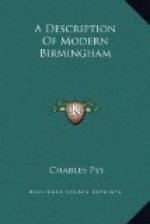This town, not being restricted by any charter, strangers from whatever quarter they may come, here find an asylum, and pursue their avocations with as much freedom, and are no more subject to molestation, than a native inhabitant. Trade of every kind may be exercised here, and let a person’s religious opinions be whatever they may, he is at liberty to exercise them; there being in this town eight places of public worship, according to the establishment, one for the society of friends, two for protestant dissenters, three for calvinists, two for Roman catholics, four for methodists, four for baptists, one for Swedenburgians, one for jews, and one for the followers of Lady Huntingdon.
The buildings in this town extend to the distance of near three miles in every direction, reckoning from the top of Camphill, and it was some years back, upon a certainty, the largest town in the kingdom. This was ascertained by actual measurement; for soon after Mr. Aikin published his history of Manchester, Mr. John Snape, a very accurate surveyor, drew a plan of this town, upon the same scale as Mr. Aikin’s. Since that time, I cannot say which of the two towns have encreased the most; but, if Manchester has extended its buildings with more rapidity than Birmingham, it is a very extensive place.
Notwithstanding the extent of this town, there is very little distinction between it and a village; all the difference is, its fairs and market, for the smallest town has a constable to preside over it, and this, although so extensive and populous, is governed by two constables.
Although this town is of such considerable magnitude, and one of the principal thoroughfares between London and Dublin, there are no more than three places where the superior class of travellers can be accommodated with horses and carriages; the Royal Hotel, near St. Philip’s church; the Swan Hotel, in High-street, and the Hen and Chickens Hotel, in New-street.
For the accommodation of the next class, there are the following taverns and inns: the Stork, in the Square; the Nelson, opposite the statue of his lordship, in the market-place; the Union, in Union-street; the Saracen’s Head, in Bull-street; the George, and the Castle, in High-street; the Red Lion, the George, and the White Hart, in Digbeth; the Rose, in Edgbaston-street; and the, Woolpack, in Moor-street.
From the Nelson, the Swan, the Hen and Chickens, the Saracen’s Head, the George, or the Castle, those who travel by public carriages may be conveyed to any part of the kingdom. The principal avenue leading to and from this town is Great Hampton-street, which, as its name imports, is on the road to Wolverhampton, but it is also the road to Walsall and likewise to Dudley. In this capacious road several streets concentrate, but I would recommend a stranger to proceed down Snowhill.




